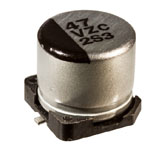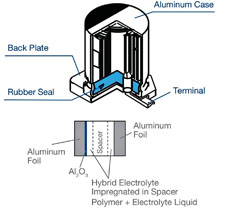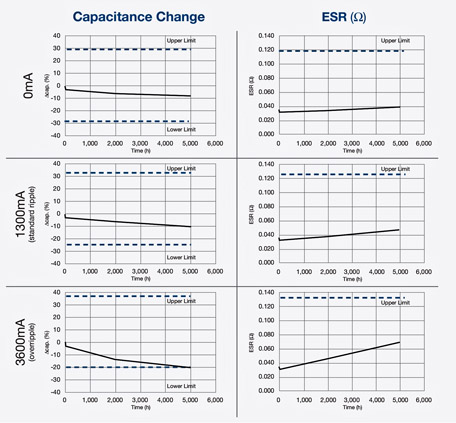BY ROB O’ CONNOR
Product Manager, Capacitor Business Div.
Panasonic Industrial Devices
www.panasonic.com/industrial
Capacitors may seem simple enough, but specifying them has grown more complex in recent years. The reason why comes down to freedom of choice. The universe of capacitors for embedded systems applications has expanded greatly over the past few years, in large part because of capacitor designs that take advantage of advances in conductive polymers.
These advanced capacitors sometimes use conductive polymers to form the entire electrolyte. Or the conductive polymers can be used in conjunction with a liquid electrolyte in a design known as a hybrid capacitor (see Fig. 1 ). Either way, these polymer-based capacitors offer a performance edge over conventional electrolytic and ceramic capacitors when it comes to:
- ESR and voltage rating
- Stability
- Longevity and reliability
- Safety
- Life cycle cost
The various polymer and hybrid capacitors have distinct sweet spots in terms of their ideal voltages, frequency characteristics, and environmental conditions.
Polymer capacitor varieties
- Layered polymer aluminum capacitors (see Fig. 2 ) use conductive polymer as the electrolyte and have an aluminum cathode. They cover a voltage range from 2 to 25 V and offer 2.2 to 560 μF. Their distinguishing electrical characteristic is extremely low ESR. Packaged in a molded resin as compact surface-mount devices, these devices feature a low profile.
- Wound polymer aluminum capacitors are also based on conductive polymers and aluminum, but they have a wound foil structure. They cover a wider range of voltages and capacitance values than other polymer capacitors. Voltages extend from 2.5 to 100 V and capacitances run from 3.3 to 2700 μF. Like the layered polymer capacitors, the wound style has extremely low ESR values. They can be surface mounted, though they are not quite as compact as the layered capacitors.
- Polymer tantalum capacitors employ a conductive polymer electrolyte and a tantalum cathode. They span from 1.8 to 35 V with capacitances from 2.7 to 680 μF and have low ESR. Packaged in a molded resin case, the tantalum polymer capacitors are among the most compact on the market.
- Polymer hybrid aluminum capacitors use a combination of a liquid and conductive polymer to serve as the electrolyte have an aluminum cathode — the best of both worlds. The polymer offers high conductivity —and a correspondingly low ESR. The liquid portion withstand high voltages and provide higher capacitance ratings due to its large effective surface area. They offer a voltages of 25 to 80 V and capacitances between 10 and 330 μF. At 20 to 120 mΩ, ESR values for hybrids are higher than other types of polymer capacitors, but still very low.

Fig 1: Hybrid capacitor technology combines the performance benefits of electrolytic and polymer.
Polymer capacitor advantages
Despite differences in their materials and construction, the four types of polymer capacitors share a collection of desirable electrical properties:
- Great frequency characteristics: With very low ESR, polymer capacitors have low impedance near their resonance point, which reduces ripple in power circuits. Our testing has revealed as much as a fivefold reduction in peak-to-peak voltage changes when comparing polymer capacitors to conventional low-ESR tantalum capacitors.
- Stable capacitance: With ceramic, capacitance drifts in response to temperature and DC bias. Polymer capacitors have no such problem and remain stable. This stability is particularly important in industrial and automotive applications, which tend to experience broad operating temperatures. We've seen cases where elevated temperatures caused an effective capacitance loss of 90% or more for ceramic capacitors. Hybrid capacitors keep a stable capacitance in the face of common operating conditions — high frequencies and low temperatures — that reduce the capacitance of conventional liquid electrolytic capacitors.
- Enhanced safety: Conventional electrolytic capacitors can suffer from safety issues that could cause them to short circuit and fail. The problem arises when electrical overload or mechanical stresses create defects or discontinuities in the oxide film that forms the dielectric. Polymer capacitors have a self-healing capability that eliminates this failure mode. Heating breaks the molecular chain of the conductive polymer near the defect, driving up its resistance and effectively forming a barrier against any current leaking from the electrode. In the case of hybrid capacitors, an additional self-healing mechanism comes into play-because the liquid electrolyte causes current flow near the defect to reoxidize the aluminum. We have conducted numerous overvoltage tests to demonstrate the self-repairing nature of polymer and hybrid capacitors. One such test compared our SP-Cap polymer capacitors to a conventional tantalum-MnO2 capacitor. The polymer model withstood short currents as high as 7 A, while the tantalum capacitor started smoking at 3 A and ignited at 5 A. This safety enhancement has important design and cost implications. Conventional tantalum capacitors are normally derated in use by 30% to 50% their labeled voltage to ensure that they operate safely. This derating, while a common and accepted engineering practice, results in an upsizing of capacitors and increased cost. For our polymer capacitors, by contrast, we guarantee operation at 90% of the full-rated voltage.

Fig. 2: Polymer hybrid aluminum capacitors use a combination of a liquid and conductive polymer to serve as the electrolyte and aluminum as the cathode.
Hybrid cpacitor performance advantages
Driven by miniaturization and higher switching frequencies of many electrical devices, hybrid capacitors have started to get more traction. Hybrids are known for their stable electrical characteristics at high frequencies. These robust capacitors also have other compelling advantages that make a difference in applications such as computer servers, backup devices and networking gear as well as industrial motors, automotive engine control units, security cameras, and LED lighting. Among the advantages:
- Hybrids are compact. Surface mount hybrid capacitors measuring just 6.3 x 5.8 mm can handle 35 V with a capacitance of 47 μF. The small size can save a significant amount of board space. In a recent 48 V power supply application, hybrid capacitors occupied just 13% of the board space that was required by aluminum electrolytic capacitors.
- Hybrids maximize reliability. By nearly every measure, hybrid capacitors outperform equivalent aluminum electrolytic and polymer capacitors. To take a few examples, hybrid capacitors have significantly better endurance and humidity resistance than either their electrolytic or polymer counterparts. Hybrids also have significantly higher tolerance for large ripple currents, inrush currents and elevated temperature.
Taken together, the size and reliability produce a strong cost benefit for using hybrid capacitors – in spite of their higher upfront prices. The higher ripple current specification alone can result in a 20% reduction in cost by increasing the life cycle of the capacitor. In the 48-V power supply application we just mentioned, the hybrid capacitors had a total cost 50% lower than the equivalent aluminum electrolytic capacitors, with the savings coming from reductions in board cost, warranty cost,and ability to withstand high ripple current (see Fig. 3 ).

Fig. 3: Hybrid capacitors exhibit high reliability when subjected to high ripple currents. In recent testing, the capacitors had the electrical characteristics at no load and rated ripple current (1300mA) conditions. At three times the rated ripple current (3600mA), the capacitor's electrical characteristics did change, but no shortage took place .
Advertisement
Learn more about Panasonic Industrial Sales Company of America





